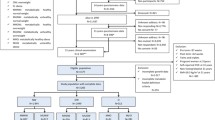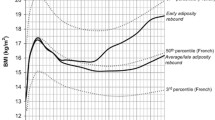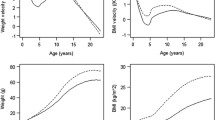Abstract
Background/Objectives:
To investigate sex-specific associations of birth weight with body mass index (BMI), waist circumference (WC) and waist-to-hip ratio (WHR) in mid-to-late adulthood.
Subjects/Methods:
ELSA-Brasil is a multicenter cohort study of adults aged 35–74 years affiliated with universities or research institutions of six capital cities in Brazil. After exclusions, we investigated 11 636 participants. Socio-demographic factors and birth weight were obtained by interview. All anthropometry was directly measured at baseline. We categorized birth weight as low (⩽2.5 kg); normal (2.5–4 kg) and high (⩾4 kg). We performed analysis of covariance (ANCOVA) for continuous outcomes and ordinal logistic regression for categorical adiposity outcomes. We examined interaction on the multiplicative scale by sex and by race.
Results:
High birth weight uniformly predicted greater overall and central obesity in men and women. However, low (vs normal) birth weight, in ANCOVA models adjusted for participant age, family income, race, education, maternal education, and maternal and paternal history of diabetes, was associated with lower BMI, WC and WHR means for men, but not for women (Pinteraction=0.01, <0.0001 and <0.0001, respectively). In similarly adjusted ordinal logistic regression models, odds of obesity (odds ratio (OR)=0.65, 0.46–0.90) and of being in the high (vs low) tertile of WC (OR=0.66, 0.50–0.87) and of WHR (OR=0.79, 0.60–1.03) were lower for low (vs normal) birth weight men, but trended higher (BMI: OR=1.18, 0.92–1.51; WC: OR=1.21, 0.97–1.53; WHR: OR=1.44, 1.15–1.82) for low (vs normal) birth weight women.
Conclusions:
In this Brazilian sample of middle-aged and elderly adults who have lived through a rapid nutritional transition, low birth weight was associated with adult adiposity in a sex-specific manner. In men, low birth weight was associated with lower overall and central adult adiposity, while in women low birth weight was generally associated with greater central adiposity.


Similar content being viewed by others
References
Ng M, Fleming T, Robinson M, Thomson B, Graetz N, Margono C et al. Global, regional, and national prevalence of overweight and obesity in children and adults during 1980–2013: a systematic analysis for the Global Burden of Disease Study 2013. Lancet 2014; 384: 766–781.
Instituto Brasileiro de Geografia e Estatística. Pesquisa Nacional de Saúde: 2013: Ciclos de vida: Brasil e grandes regiões. IBGE: Rio de Janeiro, Brazil, 2015.
Yu ZB, Han SP, Zhu GZ, Zhu C, Wang XJ, Cao XG et al. Birth weight and subsequent risk of obesity: a systematic review and meta-analysis: Birth weight in relation to obesity. Obes Rev 2011; 12: 525–542.
Ravelli AC, van Der Meulen JH, Osmond C, Barker DJ, Bleker OP . Obesity at the age of 50 y in men and women exposed to famine prenatally. Am J Clin Nutr 1999; 70: 811–816.
Hult M, Tornhammar P, Ueda P, Chima C, Bonamy A-KE, Ozumba B et al. Hypertension, diabetes and overweight: looming legacies of the Biafran famine. PLoS One 2010; 5: e13582.
Imai CM, Halldorsson TI, Gunnarsdottir I, Gudnason V, Aspelund T, Jonsson G et al. Effect of birth year on birth weight and obesity in adulthood: comparison between subjects born prior to and during the great depression in Iceland. PLoS One 2012; 7: e44551.
Aquino EML, Barreto SM, Bensenor IM, Carvalho MS, Chor D, Duncan BB et al. Brazilian Longitudinal Study of Adult Health (ELSA-Brasil): objectives and design. Am J Epidemiol 2012; 175: 315–324.
Schmidt MI, Duncan BB, Mill JG, Lotufo PA, Chor D, Barreto SM et al. Cohort Profile: Longitudinal Study of Adult Health (ELSA-Brasil). Int J Epidemiol 2015; 44: 68–75.
Lohman TG, Roche AF, Martorell R . Anthropometric Standardization Reference Manual. Human Kinetics Books: Champaign, IL, USA, 1988.
Schmidt MI, Griep RH, Passos VM, Luft VC, Goulart AC, Menezes GMde S et al. [Strategies and development of quality assurance and control in the ELSA-Brasil]. Rev Saúde Pública 2013; 47 (Suppl 2): 105–112.
World Health Organization The Use and Interpretation of Anthropometry: Report of a WHO Expert Committee. WHO: Geneva, Switzerland, 1995.
Alberti KGMM, Eckel RH, Grundy SM, Zimmet PZ, Cleeman JI, Donato KA et al. Harmonizing the metabolic syndrome: a joint interim statement of the International Diabetes Federation Task Force on Epidemiology and Prevention; National Heart, Lung, and Blood Institute; American Heart Association; World Heart Federation; International Atherosclerosis Society; and International Association for the Study of Obesity. Circulation 2009; 120: 1640–1645.
Schellong K, Schulz S, Harder T, Plagemann A . Birth weight and long-term overweight risk: systematic review and a meta-analysis including 643,902 persons from 66 studies and 26 countries globally. PLoS ONE 2012; 7: e47776.
Yang TYO, Cairns BJ, Beral V On behalf of the Million Women Study Collaborators. Association between birthweight and obesity in adult females. J Epidemiol Community Health 2010; 64: A18–A19.
Araújo de França GV, Lucia Rolfe ED, Horta BL, Gigante DP, Yudkin JS, Ong KK et al. Associations of birth weight, linear growth and relative weight gain throughout life with abdominal fat depots in adulthood: the 1982 Pelotas (Brazil) birth cohort study. Int J Obes 2016; 40: 14–21.
Tam CHT, Wang Y, Luan J, Lee HM, Luk AOY, Tutino GE et al. Non-linear relationship between birthweight and cardiometabolic risk factors in Chinese adolescents and adults. Diabet Med 2015; 32: 220–225.
Labayen I, Moreno LA, Ruiz JR, González-Gross M, Wärnberg J, Breidenassel C et al. Small birth weight and later body composition and fat distribution in adolescents: the AVENA study. Obesity 2008; 16: 1680–1686.
WW-Y Fung . Early Childhood Malnutrition and Adult Obesity: Evidence from the 1959-61 China Famine. ard University Mimeograph 2009. Available from http://cahnrs-cms.wsu.edu/ses/seminars/Documents/PastSeminarsPapers/Obesity_WinnieFung.pdf.
Luo Z, Mu R, Zhang X . Famine and overweight in China. Rev Agric Econ 2006; 28: 296–304.
Saffery R, Novakovic B . Epigenetics as the mediator of fetal programming of adult onset disease: what is the evidence? Acta Obstet Gynecol Scand 2014; 93: 1090–1098.
Tobi EW, Lumey LH, Talens RP, Kremer D, Putter H, Stein AD et al. DNA methylation differences after exposure to prenatal famine are common and timing- and sex-specific. Hum Mol Genet 2009; 18: 4046–4053.
Inoshita M, Numata S, Tajima A, Kinoshita M, Umehara H, Yamamori H et al. Sex differences of leukocytes DNA methylation adjusted for estimated cellular proportions. Biol Sex Differ 2015; 6: 11.
Hall E, Volkov P, Dayeh T, Esguerra JLS, Salö S, Eliasson L et al. Sex differences in the genome-wide DNA methylation pattern and impact on gene expression, microRNA levels and insulin secretion in human pancreatic islets. Genome Biol 2014; 15: 522.
Yousefi P, Huen K, Davé V, Barcellos L, Eskenazi B, Holland N . Sex differences in DNA methylation assessed by 450 K BeadChip in newborns. BMC Genomics 2015; 16: 911.
DiPietro JA, Voegtline KM . The gestational foundation of sex differences in development and vulnerability. Neuroscience 2015. e-pub ahead of print 29 July 2015 doi:10.1016/j.neuroscience.2015.07.068.
Trivers RL, Willard DE . Natural selection of parental ability to vary the sex ratio of offspring. Science 1973; 179: 90–92.
Sandman CA, Glynn LM, Davis EP . Is there a viability-vulnerability tradeoff? Sex differences in fetal programming. J Psychosom Res 2013; 75: 327–335.
Clutton-Brock TH, Iason GR . Sex ratio variation in mammals. Q Rev Biol 1986; 61: 339–374.
Hernández-Julián R, Mansour H, Peters C . The effects of intrauterine malnutrition on birth and fertility outcomes: evidence from the 1974 Bangladesh famine. Demography 2014; 51: 1775–1796.
Mu R, Zhang X . Why does the Great Chinese Famine affect the male and female survivors differently? Mortality selection versus son preference. Econ Hum Biol 2011; 9: 92–105.
Song S . Does famine influence sex ratio at birth? Evidence from the 1959-1961 Great Leap Forward Famine in China. Proc Biol Sci 2012; 279: 2883–2890.
Lumey LH, Stein AD, Susser E . Prenatal famine and adult health. Annu Rev Public Health 2011; 32: 237–262.
Ribeiro AM, Guimarães MJ, Lima M de C, Sarinho SW, Coutinho SB . [Fatores de risco para mortalidade neonatal em crianças com baixo peso ao nascer]. Rev Saúde Pública 2009; 43: 246–255.
Sanderson M, Williams MA, White E, Daling JR, Holt VL, Malone KE et al. Validity and reliability of subject and mother reporting of perinatal factors. Am J Epidemiol 1998; 147: 136–140.
Troy LM, Michels KB, Hunter DJ, Spiegelman D, Manson JE, Colditz GA et al. Self-reported birthweight and history of having been breastfed among younger women: an assessment of validity. Int J Epidemiol 1996; 25: 122–127.
Kemp M, Gunnell D, Maynard M, Smith GD, Frankel S . How accurate is self reported birth weight among the elderly? J Epidemiol Community Health 2000; 54: 639.
Curhan GC, Chertow GM, Willett WC, Spiegelman D, Colditz GA, Manson JE et al. Birth weight and adult hypertension and obesity in women. Circulation 1996; 94: 1310–1315.
Acknowledgements
This work was supported by the Brazilian Ministry of Health (Science and Technology Department) and the Brazilian Ministry of Science and Technology (Financiadora de Estudos e Projetos - FINEP and the National Council for Scientific and Technological Development - CNPq) (grant numbers 01 06 0010.00 RS, 01 06 0212.00 BA, 01 06 0300.00 ES, 01 06 0278.00 MG, 01 06 0115.00 SP, 01 06 0071.00 RJ).
Author contributions
MIS and BBD conceived the study, interpreted the data and prepared the final manuscript. VL, GR, MCS and AV analyzed and interpreted the data and prepared the final manuscript. NTM interpreted the data and prepared the final manuscript. SMB and IMB conceived the study and assisted in drafting the manuscript. SMAM, MJMF and LJA assisted in drafting the manuscript. All authors approved the final manuscript.
Author information
Authors and Affiliations
Corresponding author
Ethics declarations
Competing interests
The authors declare no conflict of interest.
Rights and permissions
About this article
Cite this article
Rockenbach, G., Luft, V., Mueller, N. et al. Sex-specific associations of birth weight with measures of adiposity in mid-to-late adulthood: the Brazilian Longitudinal Study of Adult Health (ELSA-Brasil). Int J Obes 40, 1286–1291 (2016). https://doi.org/10.1038/ijo.2016.76
Received:
Revised:
Accepted:
Published:
Issue Date:
DOI: https://doi.org/10.1038/ijo.2016.76
- Springer Nature Limited
This article is cited by
-
Maternal investment, life-history trajectory of the off-spring and cardiovascular disease risk in Emirati females in the United Arab Emirates
BMC Public Health (2021)
-
From conception to infancy — early risk factors for childhood obesity
Nature Reviews Endocrinology (2019)
-
Developmental Programming of Body Composition: Update on Evidence and Mechanisms
Current Diabetes Reports (2019)
-
Birthweight and cardiometabolic risk patterns in multiracial children
International Journal of Obesity (2018)




